Analyzing the Northern Territory Intervention and Indigenous Health
VerifiedAdded on 2020/02/19
|7
|2875
|52
Essay
AI Summary
This essay critically examines the Northern Territory Intervention (NTER), a controversial government initiative implemented in 2007 in response to concerns about violence, abuse, and poor health within Indigenous communities in the Northern Territory. The essay explores the intervention's multifaceted measures, including land acquisition, health initiatives, and restrictions on alcohol and pornography. It analyzes the intervention's shortcomings, particularly the lack of cultural sensitivity and community engagement, highlighting the negative impacts on Indigenous spiritual and cultural well-being. The essay discusses the clash of cultural views, institutional racism, and the effectiveness of the intervention. It also investigates the compulsory income management scheme, the suspension of the Racial Discrimination Act, and the subsequent introduction of the Stronger Futures in the Northern Territory Bill. The conclusion emphasizes the need for government collaboration with Indigenous communities, culturally appropriate strategies, and governance that respects Indigenous knowledge and aspirations to improve health outcomes.
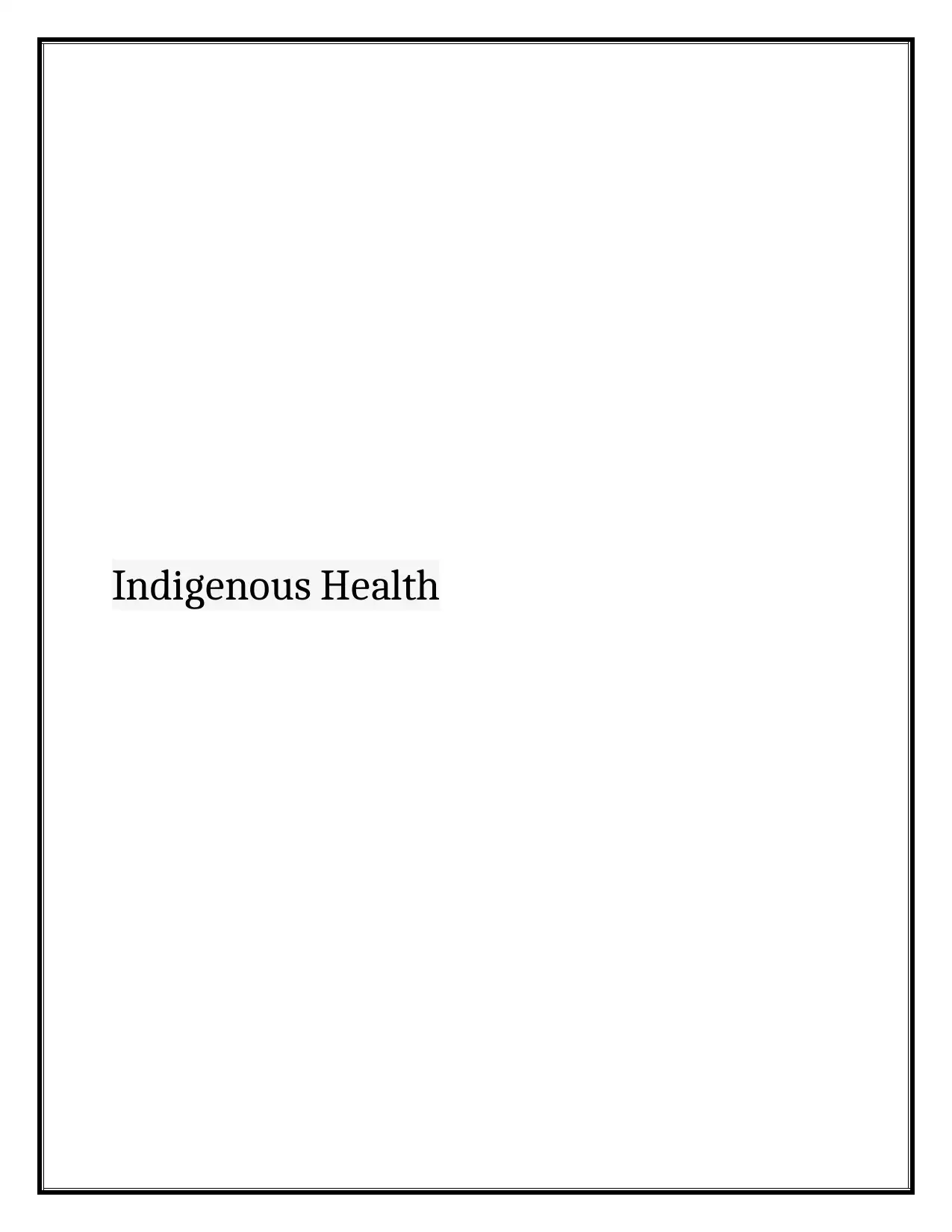
Indigenous Health
Paraphrase This Document
Need a fresh take? Get an instant paraphrase of this document with our AI Paraphraser
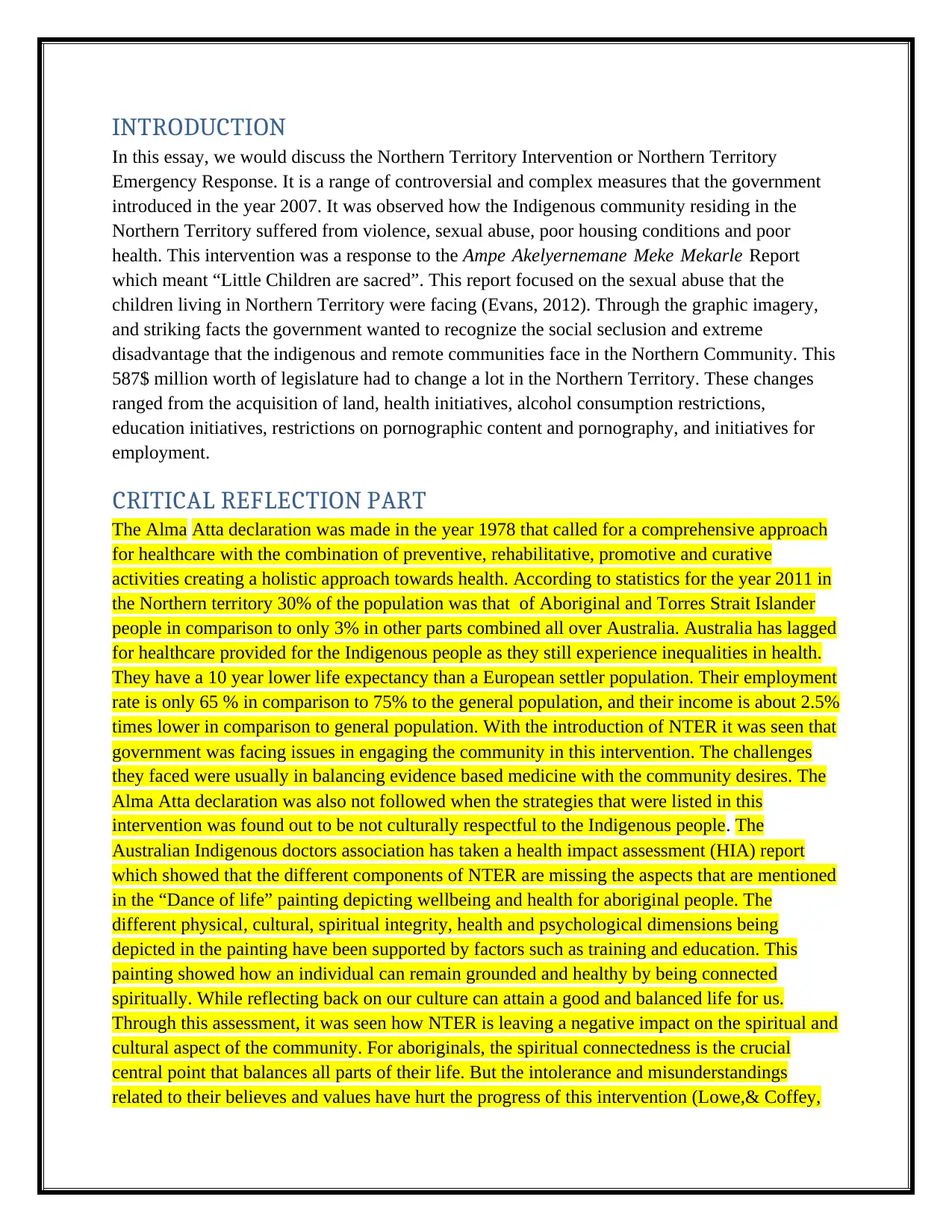
INTRODUCTION
In this essay, we would discuss the Northern Territory Intervention or Northern Territory
Emergency Response. It is a range of controversial and complex measures that the government
introduced in the year 2007. It was observed how the Indigenous community residing in the
Northern Territory suffered from violence, sexual abuse, poor housing conditions and poor
health. This intervention was a response to the Ampe Akelyernemane Meke Mekarle Report
which meant “Little Children are sacred”. This report focused on the sexual abuse that the
children living in Northern Territory were facing (Evans, 2012). Through the graphic imagery,
and striking facts the government wanted to recognize the social seclusion and extreme
disadvantage that the indigenous and remote communities face in the Northern Community. This
587$ million worth of legislature had to change a lot in the Northern Territory. These changes
ranged from the acquisition of land, health initiatives, alcohol consumption restrictions,
education initiatives, restrictions on pornographic content and pornography, and initiatives for
employment.
CRITICAL REFLECTION PART
The Alma Atta declaration was made in the year 1978 that called for a comprehensive approach
for healthcare with the combination of preventive, rehabilitative, promotive and curative
activities creating a holistic approach towards health. According to statistics for the year 2011 in
the Northern territory 30% of the population was that of Aboriginal and Torres Strait Islander
people in comparison to only 3% in other parts combined all over Australia. Australia has lagged
for healthcare provided for the Indigenous people as they still experience inequalities in health.
They have a 10 year lower life expectancy than a European settler population. Their employment
rate is only 65 % in comparison to 75% to the general population, and their income is about 2.5%
times lower in comparison to general population. With the introduction of NTER it was seen that
government was facing issues in engaging the community in this intervention. The challenges
they faced were usually in balancing evidence based medicine with the community desires. The
Alma Atta declaration was also not followed when the strategies that were listed in this
intervention was found out to be not culturally respectful to the Indigenous people. The
Australian Indigenous doctors association has taken a health impact assessment (HIA) report
which showed that the different components of NTER are missing the aspects that are mentioned
in the “Dance of life” painting depicting wellbeing and health for aboriginal people. The
different physical, cultural, spiritual integrity, health and psychological dimensions being
depicted in the painting have been supported by factors such as training and education. This
painting showed how an individual can remain grounded and healthy by being connected
spiritually. While reflecting back on our culture can attain a good and balanced life for us.
Through this assessment, it was seen how NTER is leaving a negative impact on the spiritual and
cultural aspect of the community. For aboriginals, the spiritual connectedness is the crucial
central point that balances all parts of their life. But the intolerance and misunderstandings
related to their believes and values have hurt the progress of this intervention (Lowe,& Coffey,
In this essay, we would discuss the Northern Territory Intervention or Northern Territory
Emergency Response. It is a range of controversial and complex measures that the government
introduced in the year 2007. It was observed how the Indigenous community residing in the
Northern Territory suffered from violence, sexual abuse, poor housing conditions and poor
health. This intervention was a response to the Ampe Akelyernemane Meke Mekarle Report
which meant “Little Children are sacred”. This report focused on the sexual abuse that the
children living in Northern Territory were facing (Evans, 2012). Through the graphic imagery,
and striking facts the government wanted to recognize the social seclusion and extreme
disadvantage that the indigenous and remote communities face in the Northern Community. This
587$ million worth of legislature had to change a lot in the Northern Territory. These changes
ranged from the acquisition of land, health initiatives, alcohol consumption restrictions,
education initiatives, restrictions on pornographic content and pornography, and initiatives for
employment.
CRITICAL REFLECTION PART
The Alma Atta declaration was made in the year 1978 that called for a comprehensive approach
for healthcare with the combination of preventive, rehabilitative, promotive and curative
activities creating a holistic approach towards health. According to statistics for the year 2011 in
the Northern territory 30% of the population was that of Aboriginal and Torres Strait Islander
people in comparison to only 3% in other parts combined all over Australia. Australia has lagged
for healthcare provided for the Indigenous people as they still experience inequalities in health.
They have a 10 year lower life expectancy than a European settler population. Their employment
rate is only 65 % in comparison to 75% to the general population, and their income is about 2.5%
times lower in comparison to general population. With the introduction of NTER it was seen that
government was facing issues in engaging the community in this intervention. The challenges
they faced were usually in balancing evidence based medicine with the community desires. The
Alma Atta declaration was also not followed when the strategies that were listed in this
intervention was found out to be not culturally respectful to the Indigenous people. The
Australian Indigenous doctors association has taken a health impact assessment (HIA) report
which showed that the different components of NTER are missing the aspects that are mentioned
in the “Dance of life” painting depicting wellbeing and health for aboriginal people. The
different physical, cultural, spiritual integrity, health and psychological dimensions being
depicted in the painting have been supported by factors such as training and education. This
painting showed how an individual can remain grounded and healthy by being connected
spiritually. While reflecting back on our culture can attain a good and balanced life for us.
Through this assessment, it was seen how NTER is leaving a negative impact on the spiritual and
cultural aspect of the community. For aboriginals, the spiritual connectedness is the crucial
central point that balances all parts of their life. But the intolerance and misunderstandings
related to their believes and values have hurt the progress of this intervention (Lowe,& Coffey,
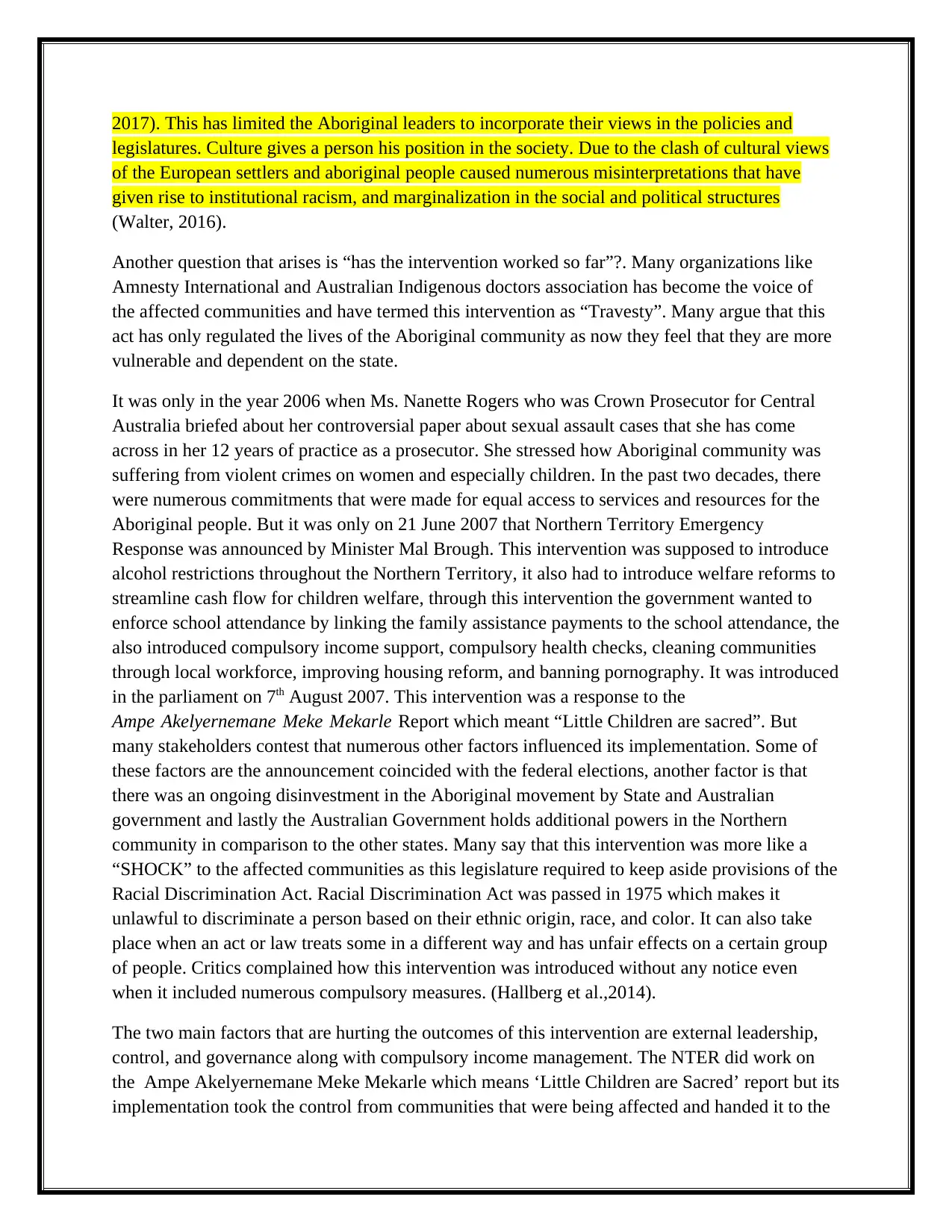
2017). This has limited the Aboriginal leaders to incorporate their views in the policies and
legislatures. Culture gives a person his position in the society. Due to the clash of cultural views
of the European settlers and aboriginal people caused numerous misinterpretations that have
given rise to institutional racism, and marginalization in the social and political structures
(Walter, 2016).
Another question that arises is “has the intervention worked so far”?. Many organizations like
Amnesty International and Australian Indigenous doctors association has become the voice of
the affected communities and have termed this intervention as “Travesty”. Many argue that this
act has only regulated the lives of the Aboriginal community as now they feel that they are more
vulnerable and dependent on the state.
It was only in the year 2006 when Ms. Nanette Rogers who was Crown Prosecutor for Central
Australia briefed about her controversial paper about sexual assault cases that she has come
across in her 12 years of practice as a prosecutor. She stressed how Aboriginal community was
suffering from violent crimes on women and especially children. In the past two decades, there
were numerous commitments that were made for equal access to services and resources for the
Aboriginal people. But it was only on 21 June 2007 that Northern Territory Emergency
Response was announced by Minister Mal Brough. This intervention was supposed to introduce
alcohol restrictions throughout the Northern Territory, it also had to introduce welfare reforms to
streamline cash flow for children welfare, through this intervention the government wanted to
enforce school attendance by linking the family assistance payments to the school attendance, the
also introduced compulsory income support, compulsory health checks, cleaning communities
through local workforce, improving housing reform, and banning pornography. It was introduced
in the parliament on 7th August 2007. This intervention was a response to the
Ampe Akelyernemane Meke Mekarle Report which meant “Little Children are sacred”. But
many stakeholders contest that numerous other factors influenced its implementation. Some of
these factors are the announcement coincided with the federal elections, another factor is that
there was an ongoing disinvestment in the Aboriginal movement by State and Australian
government and lastly the Australian Government holds additional powers in the Northern
community in comparison to the other states. Many say that this intervention was more like a
“SHOCK” to the affected communities as this legislature required to keep aside provisions of the
Racial Discrimination Act. Racial Discrimination Act was passed in 1975 which makes it
unlawful to discriminate a person based on their ethnic origin, race, and color. It can also take
place when an act or law treats some in a different way and has unfair effects on a certain group
of people. Critics complained how this intervention was introduced without any notice even
when it included numerous compulsory measures. (Hallberg et al.,2014).
The two main factors that are hurting the outcomes of this intervention are external leadership,
control, and governance along with compulsory income management. The NTER did work on
the Ampe Akelyernemane Meke Mekarle which means ‘Little Children are Sacred’ report but its
implementation took the control from communities that were being affected and handed it to the
legislatures. Culture gives a person his position in the society. Due to the clash of cultural views
of the European settlers and aboriginal people caused numerous misinterpretations that have
given rise to institutional racism, and marginalization in the social and political structures
(Walter, 2016).
Another question that arises is “has the intervention worked so far”?. Many organizations like
Amnesty International and Australian Indigenous doctors association has become the voice of
the affected communities and have termed this intervention as “Travesty”. Many argue that this
act has only regulated the lives of the Aboriginal community as now they feel that they are more
vulnerable and dependent on the state.
It was only in the year 2006 when Ms. Nanette Rogers who was Crown Prosecutor for Central
Australia briefed about her controversial paper about sexual assault cases that she has come
across in her 12 years of practice as a prosecutor. She stressed how Aboriginal community was
suffering from violent crimes on women and especially children. In the past two decades, there
were numerous commitments that were made for equal access to services and resources for the
Aboriginal people. But it was only on 21 June 2007 that Northern Territory Emergency
Response was announced by Minister Mal Brough. This intervention was supposed to introduce
alcohol restrictions throughout the Northern Territory, it also had to introduce welfare reforms to
streamline cash flow for children welfare, through this intervention the government wanted to
enforce school attendance by linking the family assistance payments to the school attendance, the
also introduced compulsory income support, compulsory health checks, cleaning communities
through local workforce, improving housing reform, and banning pornography. It was introduced
in the parliament on 7th August 2007. This intervention was a response to the
Ampe Akelyernemane Meke Mekarle Report which meant “Little Children are sacred”. But
many stakeholders contest that numerous other factors influenced its implementation. Some of
these factors are the announcement coincided with the federal elections, another factor is that
there was an ongoing disinvestment in the Aboriginal movement by State and Australian
government and lastly the Australian Government holds additional powers in the Northern
community in comparison to the other states. Many say that this intervention was more like a
“SHOCK” to the affected communities as this legislature required to keep aside provisions of the
Racial Discrimination Act. Racial Discrimination Act was passed in 1975 which makes it
unlawful to discriminate a person based on their ethnic origin, race, and color. It can also take
place when an act or law treats some in a different way and has unfair effects on a certain group
of people. Critics complained how this intervention was introduced without any notice even
when it included numerous compulsory measures. (Hallberg et al.,2014).
The two main factors that are hurting the outcomes of this intervention are external leadership,
control, and governance along with compulsory income management. The NTER did work on
the Ampe Akelyernemane Meke Mekarle which means ‘Little Children are Sacred’ report but its
implementation took the control from communities that were being affected and handed it to the
⊘ This is a preview!⊘
Do you want full access?
Subscribe today to unlock all pages.

Trusted by 1+ million students worldwide
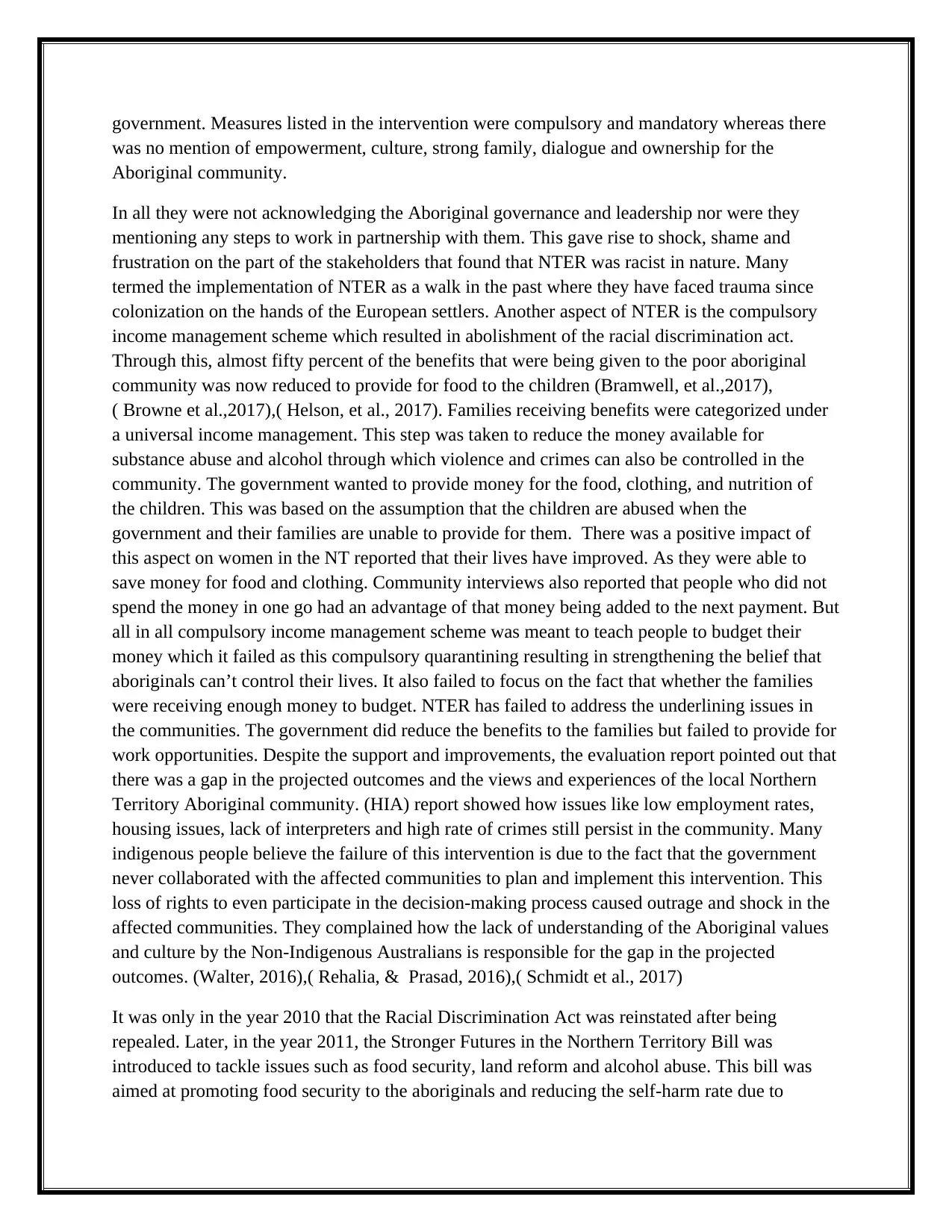
government. Measures listed in the intervention were compulsory and mandatory whereas there
was no mention of empowerment, culture, strong family, dialogue and ownership for the
Aboriginal community.
In all they were not acknowledging the Aboriginal governance and leadership nor were they
mentioning any steps to work in partnership with them. This gave rise to shock, shame and
frustration on the part of the stakeholders that found that NTER was racist in nature. Many
termed the implementation of NTER as a walk in the past where they have faced trauma since
colonization on the hands of the European settlers. Another aspect of NTER is the compulsory
income management scheme which resulted in abolishment of the racial discrimination act.
Through this, almost fifty percent of the benefits that were being given to the poor aboriginal
community was now reduced to provide for food to the children (Bramwell, et al.,2017),
( Browne et al.,2017),( Helson, et al., 2017). Families receiving benefits were categorized under
a universal income management. This step was taken to reduce the money available for
substance abuse and alcohol through which violence and crimes can also be controlled in the
community. The government wanted to provide money for the food, clothing, and nutrition of
the children. This was based on the assumption that the children are abused when the
government and their families are unable to provide for them. There was a positive impact of
this aspect on women in the NT reported that their lives have improved. As they were able to
save money for food and clothing. Community interviews also reported that people who did not
spend the money in one go had an advantage of that money being added to the next payment. But
all in all compulsory income management scheme was meant to teach people to budget their
money which it failed as this compulsory quarantining resulting in strengthening the belief that
aboriginals can’t control their lives. It also failed to focus on the fact that whether the families
were receiving enough money to budget. NTER has failed to address the underlining issues in
the communities. The government did reduce the benefits to the families but failed to provide for
work opportunities. Despite the support and improvements, the evaluation report pointed out that
there was a gap in the projected outcomes and the views and experiences of the local Northern
Territory Aboriginal community. (HIA) report showed how issues like low employment rates,
housing issues, lack of interpreters and high rate of crimes still persist in the community. Many
indigenous people believe the failure of this intervention is due to the fact that the government
never collaborated with the affected communities to plan and implement this intervention. This
loss of rights to even participate in the decision-making process caused outrage and shock in the
affected communities. They complained how the lack of understanding of the Aboriginal values
and culture by the Non-Indigenous Australians is responsible for the gap in the projected
outcomes. (Walter, 2016),( Rehalia, & Prasad, 2016),( Schmidt et al., 2017)
It was only in the year 2010 that the Racial Discrimination Act was reinstated after being
repealed. Later, in the year 2011, the Stronger Futures in the Northern Territory Bill was
introduced to tackle issues such as food security, land reform and alcohol abuse. This bill was
aimed at promoting food security to the aboriginals and reducing the self-harm rate due to
was no mention of empowerment, culture, strong family, dialogue and ownership for the
Aboriginal community.
In all they were not acknowledging the Aboriginal governance and leadership nor were they
mentioning any steps to work in partnership with them. This gave rise to shock, shame and
frustration on the part of the stakeholders that found that NTER was racist in nature. Many
termed the implementation of NTER as a walk in the past where they have faced trauma since
colonization on the hands of the European settlers. Another aspect of NTER is the compulsory
income management scheme which resulted in abolishment of the racial discrimination act.
Through this, almost fifty percent of the benefits that were being given to the poor aboriginal
community was now reduced to provide for food to the children (Bramwell, et al.,2017),
( Browne et al.,2017),( Helson, et al., 2017). Families receiving benefits were categorized under
a universal income management. This step was taken to reduce the money available for
substance abuse and alcohol through which violence and crimes can also be controlled in the
community. The government wanted to provide money for the food, clothing, and nutrition of
the children. This was based on the assumption that the children are abused when the
government and their families are unable to provide for them. There was a positive impact of
this aspect on women in the NT reported that their lives have improved. As they were able to
save money for food and clothing. Community interviews also reported that people who did not
spend the money in one go had an advantage of that money being added to the next payment. But
all in all compulsory income management scheme was meant to teach people to budget their
money which it failed as this compulsory quarantining resulting in strengthening the belief that
aboriginals can’t control their lives. It also failed to focus on the fact that whether the families
were receiving enough money to budget. NTER has failed to address the underlining issues in
the communities. The government did reduce the benefits to the families but failed to provide for
work opportunities. Despite the support and improvements, the evaluation report pointed out that
there was a gap in the projected outcomes and the views and experiences of the local Northern
Territory Aboriginal community. (HIA) report showed how issues like low employment rates,
housing issues, lack of interpreters and high rate of crimes still persist in the community. Many
indigenous people believe the failure of this intervention is due to the fact that the government
never collaborated with the affected communities to plan and implement this intervention. This
loss of rights to even participate in the decision-making process caused outrage and shock in the
affected communities. They complained how the lack of understanding of the Aboriginal values
and culture by the Non-Indigenous Australians is responsible for the gap in the projected
outcomes. (Walter, 2016),( Rehalia, & Prasad, 2016),( Schmidt et al., 2017)
It was only in the year 2010 that the Racial Discrimination Act was reinstated after being
repealed. Later, in the year 2011, the Stronger Futures in the Northern Territory Bill was
introduced to tackle issues such as food security, land reform and alcohol abuse. This bill was
aimed at promoting food security to the aboriginals and reducing the self-harm rate due to
Paraphrase This Document
Need a fresh take? Get an instant paraphrase of this document with our AI Paraphraser
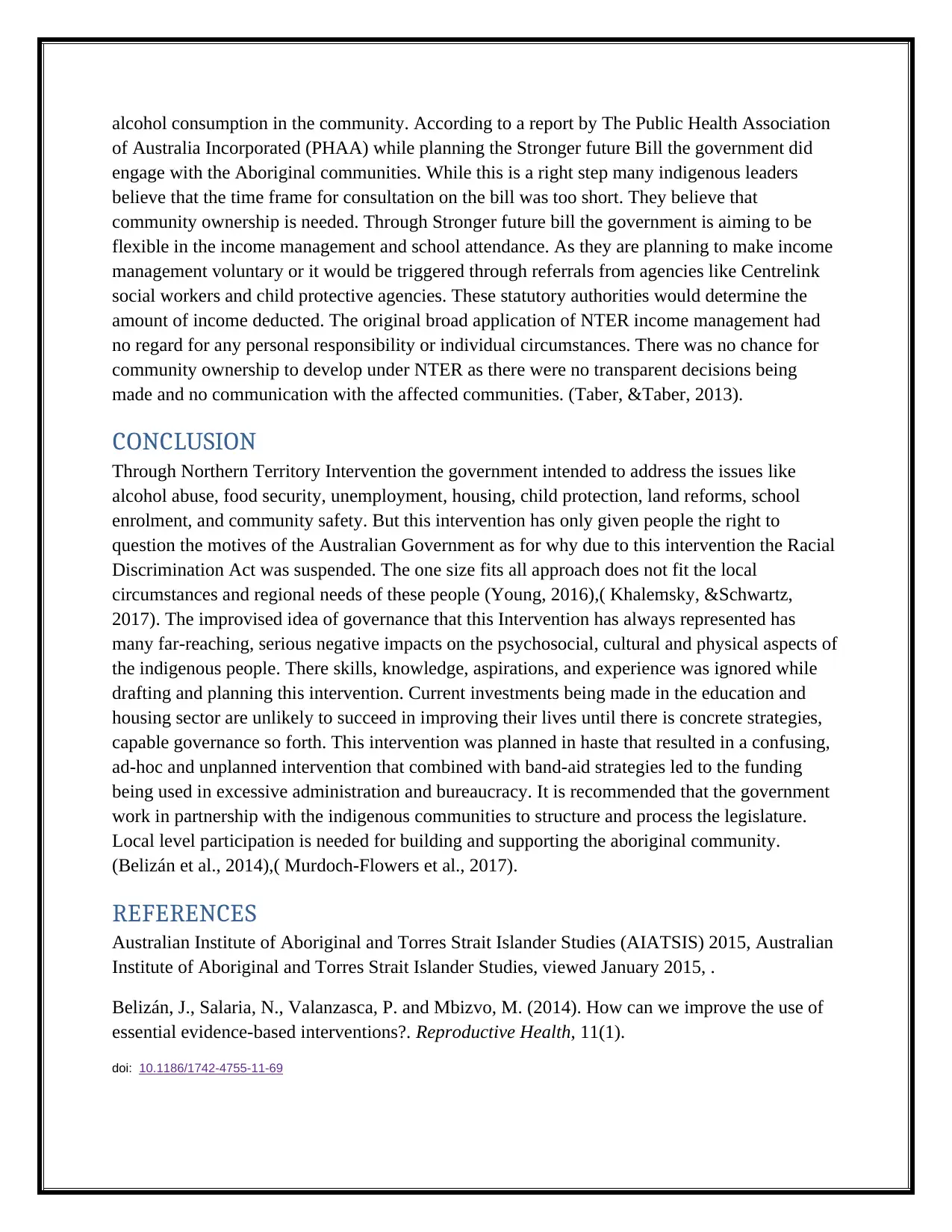
alcohol consumption in the community. According to a report by The Public Health Association
of Australia Incorporated (PHAA) while planning the Stronger future Bill the government did
engage with the Aboriginal communities. While this is a right step many indigenous leaders
believe that the time frame for consultation on the bill was too short. They believe that
community ownership is needed. Through Stronger future bill the government is aiming to be
flexible in the income management and school attendance. As they are planning to make income
management voluntary or it would be triggered through referrals from agencies like Centrelink
social workers and child protective agencies. These statutory authorities would determine the
amount of income deducted. The original broad application of NTER income management had
no regard for any personal responsibility or individual circumstances. There was no chance for
community ownership to develop under NTER as there were no transparent decisions being
made and no communication with the affected communities. (Taber, &Taber, 2013).
CONCLUSION
Through Northern Territory Intervention the government intended to address the issues like
alcohol abuse, food security, unemployment, housing, child protection, land reforms, school
enrolment, and community safety. But this intervention has only given people the right to
question the motives of the Australian Government as for why due to this intervention the Racial
Discrimination Act was suspended. The one size fits all approach does not fit the local
circumstances and regional needs of these people (Young, 2016),( Khalemsky, &Schwartz,
2017). The improvised idea of governance that this Intervention has always represented has
many far-reaching, serious negative impacts on the psychosocial, cultural and physical aspects of
the indigenous people. There skills, knowledge, aspirations, and experience was ignored while
drafting and planning this intervention. Current investments being made in the education and
housing sector are unlikely to succeed in improving their lives until there is concrete strategies,
capable governance so forth. This intervention was planned in haste that resulted in a confusing,
ad-hoc and unplanned intervention that combined with band-aid strategies led to the funding
being used in excessive administration and bureaucracy. It is recommended that the government
work in partnership with the indigenous communities to structure and process the legislature.
Local level participation is needed for building and supporting the aboriginal community.
(Belizán et al., 2014),( Murdoch-Flowers et al., 2017).
REFERENCES
Australian Institute of Aboriginal and Torres Strait Islander Studies (AIATSIS) 2015, Australian
Institute of Aboriginal and Torres Strait Islander Studies, viewed January 2015, .
Belizán, J., Salaria, N., Valanzasca, P. and Mbizvo, M. (2014). How can we improve the use of
essential evidence-based interventions?. Reproductive Health, 11(1).
doi: 10.1186/1742-4755-11-69
of Australia Incorporated (PHAA) while planning the Stronger future Bill the government did
engage with the Aboriginal communities. While this is a right step many indigenous leaders
believe that the time frame for consultation on the bill was too short. They believe that
community ownership is needed. Through Stronger future bill the government is aiming to be
flexible in the income management and school attendance. As they are planning to make income
management voluntary or it would be triggered through referrals from agencies like Centrelink
social workers and child protective agencies. These statutory authorities would determine the
amount of income deducted. The original broad application of NTER income management had
no regard for any personal responsibility or individual circumstances. There was no chance for
community ownership to develop under NTER as there were no transparent decisions being
made and no communication with the affected communities. (Taber, &Taber, 2013).
CONCLUSION
Through Northern Territory Intervention the government intended to address the issues like
alcohol abuse, food security, unemployment, housing, child protection, land reforms, school
enrolment, and community safety. But this intervention has only given people the right to
question the motives of the Australian Government as for why due to this intervention the Racial
Discrimination Act was suspended. The one size fits all approach does not fit the local
circumstances and regional needs of these people (Young, 2016),( Khalemsky, &Schwartz,
2017). The improvised idea of governance that this Intervention has always represented has
many far-reaching, serious negative impacts on the psychosocial, cultural and physical aspects of
the indigenous people. There skills, knowledge, aspirations, and experience was ignored while
drafting and planning this intervention. Current investments being made in the education and
housing sector are unlikely to succeed in improving their lives until there is concrete strategies,
capable governance so forth. This intervention was planned in haste that resulted in a confusing,
ad-hoc and unplanned intervention that combined with band-aid strategies led to the funding
being used in excessive administration and bureaucracy. It is recommended that the government
work in partnership with the indigenous communities to structure and process the legislature.
Local level participation is needed for building and supporting the aboriginal community.
(Belizán et al., 2014),( Murdoch-Flowers et al., 2017).
REFERENCES
Australian Institute of Aboriginal and Torres Strait Islander Studies (AIATSIS) 2015, Australian
Institute of Aboriginal and Torres Strait Islander Studies, viewed January 2015, .
Belizán, J., Salaria, N., Valanzasca, P. and Mbizvo, M. (2014). How can we improve the use of
essential evidence-based interventions?. Reproductive Health, 11(1).
doi: 10.1186/1742-4755-11-69
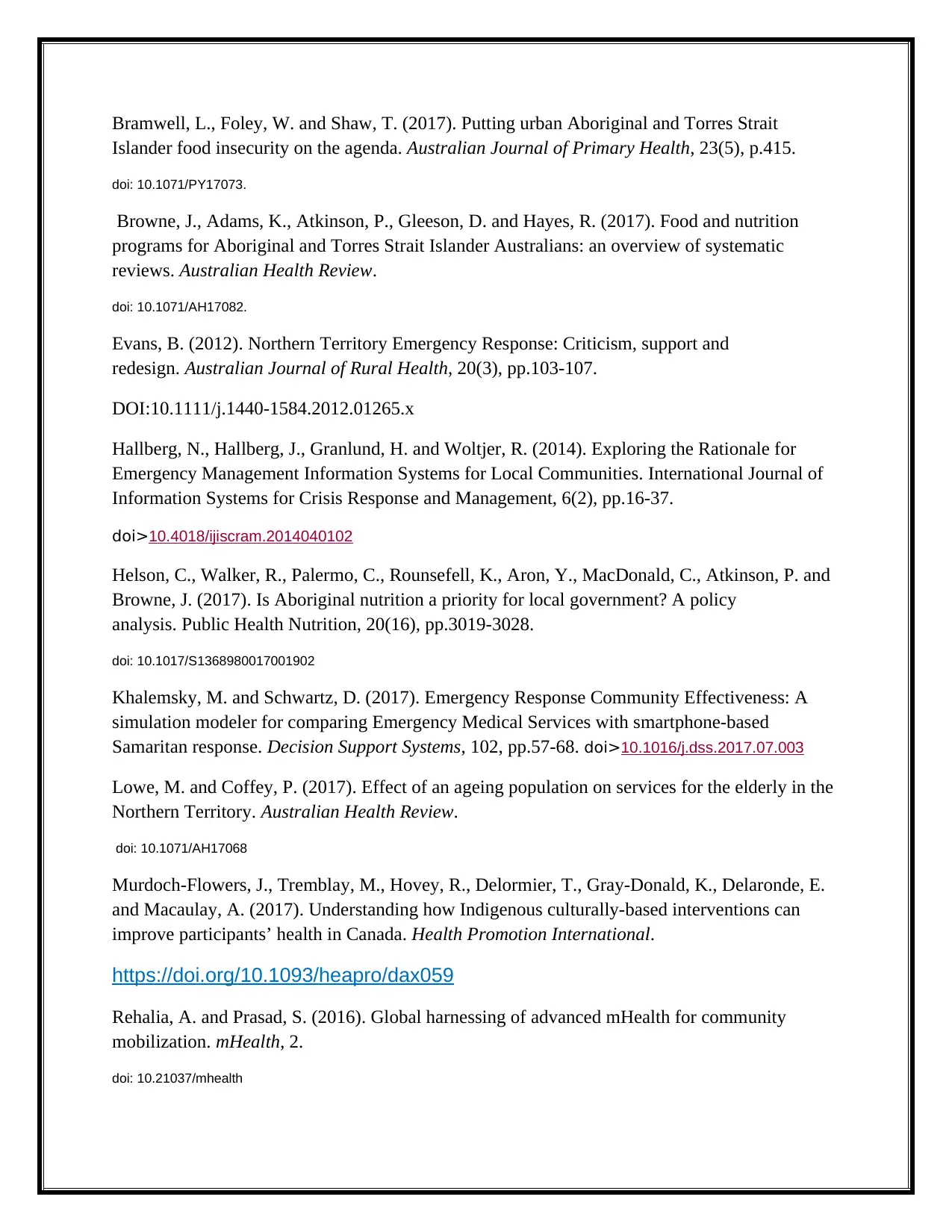
Bramwell, L., Foley, W. and Shaw, T. (2017). Putting urban Aboriginal and Torres Strait
Islander food insecurity on the agenda. Australian Journal of Primary Health, 23(5), p.415.
doi: 10.1071/PY17073.
Browne, J., Adams, K., Atkinson, P., Gleeson, D. and Hayes, R. (2017). Food and nutrition
programs for Aboriginal and Torres Strait Islander Australians: an overview of systematic
reviews. Australian Health Review.
doi: 10.1071/AH17082.
Evans, B. (2012). Northern Territory Emergency Response: Criticism, support and
redesign. Australian Journal of Rural Health, 20(3), pp.103-107.
DOI:10.1111/j.1440-1584.2012.01265.x
Hallberg, N., Hallberg, J., Granlund, H. and Woltjer, R. (2014). Exploring the Rationale for
Emergency Management Information Systems for Local Communities. International Journal of
Information Systems for Crisis Response and Management, 6(2), pp.16-37.
doi>10.4018/ijiscram.2014040102
Helson, C., Walker, R., Palermo, C., Rounsefell, K., Aron, Y., MacDonald, C., Atkinson, P. and
Browne, J. (2017). Is Aboriginal nutrition a priority for local government? A policy
analysis. Public Health Nutrition, 20(16), pp.3019-3028.
doi: 10.1017/S1368980017001902
Khalemsky, M. and Schwartz, D. (2017). Emergency Response Community Effectiveness: A
simulation modeler for comparing Emergency Medical Services with smartphone-based
Samaritan response. Decision Support Systems, 102, pp.57-68. doi>10.1016/j.dss.2017.07.003
Lowe, M. and Coffey, P. (2017). Effect of an ageing population on services for the elderly in the
Northern Territory. Australian Health Review.
doi: 10.1071/AH17068
Murdoch-Flowers, J., Tremblay, M., Hovey, R., Delormier, T., Gray-Donald, K., Delaronde, E.
and Macaulay, A. (2017). Understanding how Indigenous culturally-based interventions can
improve participants’ health in Canada. Health Promotion International.
https://doi.org/10.1093/heapro/dax059
Rehalia, A. and Prasad, S. (2016). Global harnessing of advanced mHealth for community
mobilization. mHealth, 2.
doi: 10.21037/mhealth
Islander food insecurity on the agenda. Australian Journal of Primary Health, 23(5), p.415.
doi: 10.1071/PY17073.
Browne, J., Adams, K., Atkinson, P., Gleeson, D. and Hayes, R. (2017). Food and nutrition
programs for Aboriginal and Torres Strait Islander Australians: an overview of systematic
reviews. Australian Health Review.
doi: 10.1071/AH17082.
Evans, B. (2012). Northern Territory Emergency Response: Criticism, support and
redesign. Australian Journal of Rural Health, 20(3), pp.103-107.
DOI:10.1111/j.1440-1584.2012.01265.x
Hallberg, N., Hallberg, J., Granlund, H. and Woltjer, R. (2014). Exploring the Rationale for
Emergency Management Information Systems for Local Communities. International Journal of
Information Systems for Crisis Response and Management, 6(2), pp.16-37.
doi>10.4018/ijiscram.2014040102
Helson, C., Walker, R., Palermo, C., Rounsefell, K., Aron, Y., MacDonald, C., Atkinson, P. and
Browne, J. (2017). Is Aboriginal nutrition a priority for local government? A policy
analysis. Public Health Nutrition, 20(16), pp.3019-3028.
doi: 10.1017/S1368980017001902
Khalemsky, M. and Schwartz, D. (2017). Emergency Response Community Effectiveness: A
simulation modeler for comparing Emergency Medical Services with smartphone-based
Samaritan response. Decision Support Systems, 102, pp.57-68. doi>10.1016/j.dss.2017.07.003
Lowe, M. and Coffey, P. (2017). Effect of an ageing population on services for the elderly in the
Northern Territory. Australian Health Review.
doi: 10.1071/AH17068
Murdoch-Flowers, J., Tremblay, M., Hovey, R., Delormier, T., Gray-Donald, K., Delaronde, E.
and Macaulay, A. (2017). Understanding how Indigenous culturally-based interventions can
improve participants’ health in Canada. Health Promotion International.
https://doi.org/10.1093/heapro/dax059
Rehalia, A. and Prasad, S. (2016). Global harnessing of advanced mHealth for community
mobilization. mHealth, 2.
doi: 10.21037/mhealth
⊘ This is a preview!⊘
Do you want full access?
Subscribe today to unlock all pages.

Trusted by 1+ million students worldwide
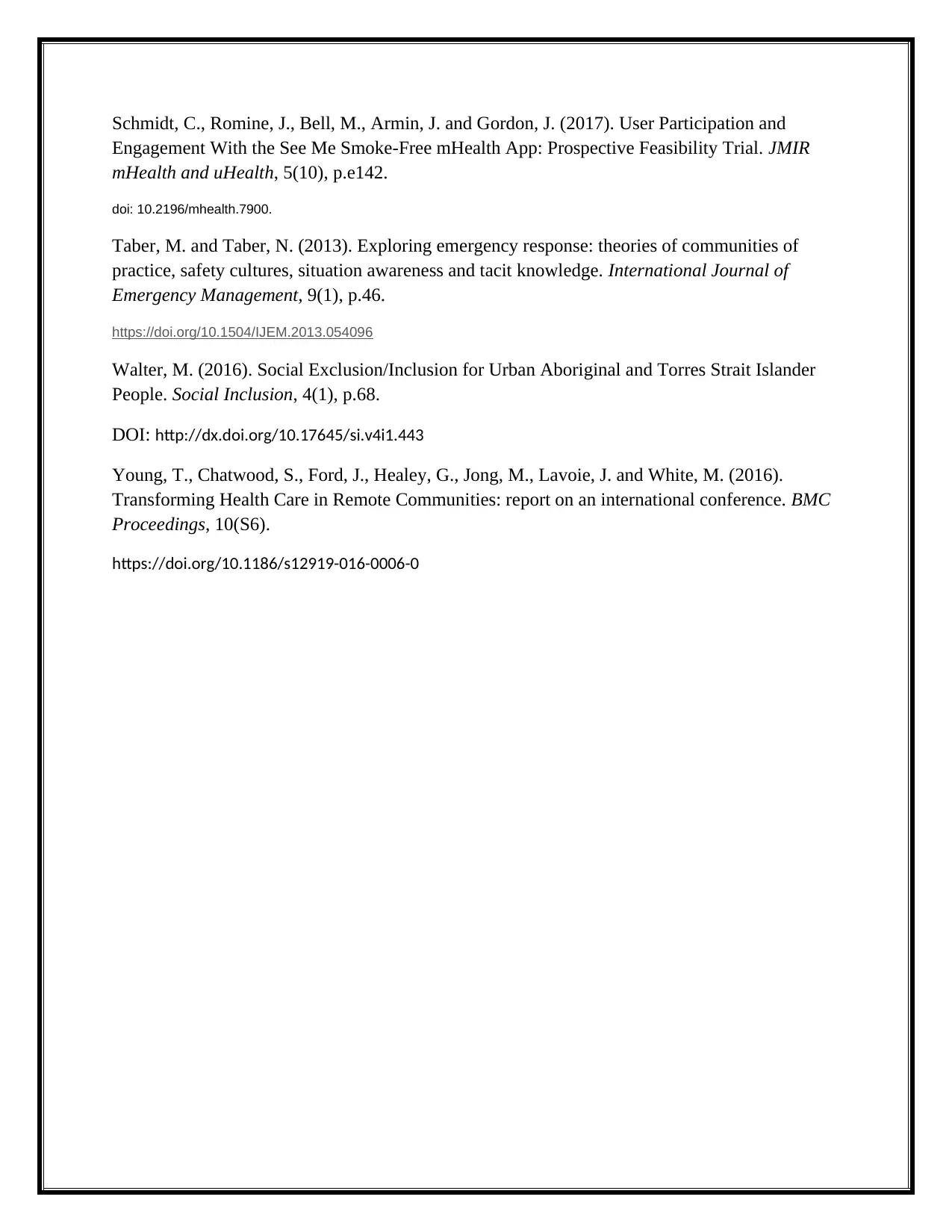
Schmidt, C., Romine, J., Bell, M., Armin, J. and Gordon, J. (2017). User Participation and
Engagement With the See Me Smoke-Free mHealth App: Prospective Feasibility Trial. JMIR
mHealth and uHealth, 5(10), p.e142.
doi: 10.2196/mhealth.7900.
Taber, M. and Taber, N. (2013). Exploring emergency response: theories of communities of
practice, safety cultures, situation awareness and tacit knowledge. International Journal of
Emergency Management, 9(1), p.46.
https://doi.org/10.1504/IJEM.2013.054096
Walter, M. (2016). Social Exclusion/Inclusion for Urban Aboriginal and Torres Strait Islander
People. Social Inclusion, 4(1), p.68.
DOI: http://dx.doi.org/10.17645/si.v4i1.443
Young, T., Chatwood, S., Ford, J., Healey, G., Jong, M., Lavoie, J. and White, M. (2016).
Transforming Health Care in Remote Communities: report on an international conference. BMC
Proceedings, 10(S6).
https://doi.org/10.1186/s12919-016-0006-0
Engagement With the See Me Smoke-Free mHealth App: Prospective Feasibility Trial. JMIR
mHealth and uHealth, 5(10), p.e142.
doi: 10.2196/mhealth.7900.
Taber, M. and Taber, N. (2013). Exploring emergency response: theories of communities of
practice, safety cultures, situation awareness and tacit knowledge. International Journal of
Emergency Management, 9(1), p.46.
https://doi.org/10.1504/IJEM.2013.054096
Walter, M. (2016). Social Exclusion/Inclusion for Urban Aboriginal and Torres Strait Islander
People. Social Inclusion, 4(1), p.68.
DOI: http://dx.doi.org/10.17645/si.v4i1.443
Young, T., Chatwood, S., Ford, J., Healey, G., Jong, M., Lavoie, J. and White, M. (2016).
Transforming Health Care in Remote Communities: report on an international conference. BMC
Proceedings, 10(S6).
https://doi.org/10.1186/s12919-016-0006-0
1 out of 7
Related Documents
Your All-in-One AI-Powered Toolkit for Academic Success.
+13062052269
info@desklib.com
Available 24*7 on WhatsApp / Email
![[object Object]](/_next/static/media/star-bottom.7253800d.svg)
Unlock your academic potential
Copyright © 2020–2025 A2Z Services. All Rights Reserved. Developed and managed by ZUCOL.





